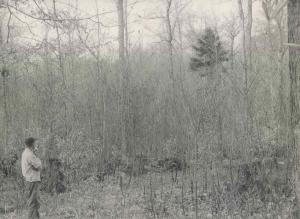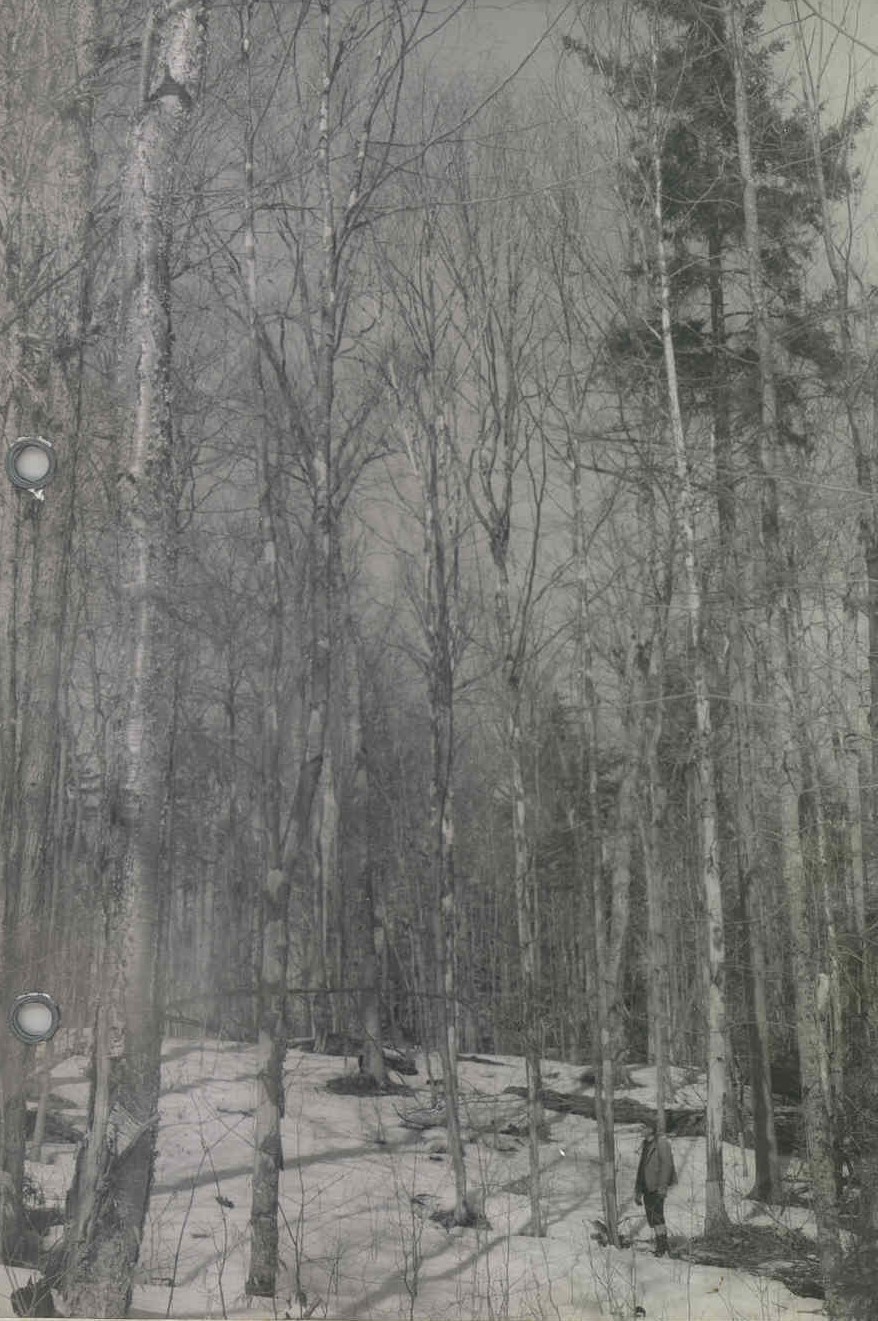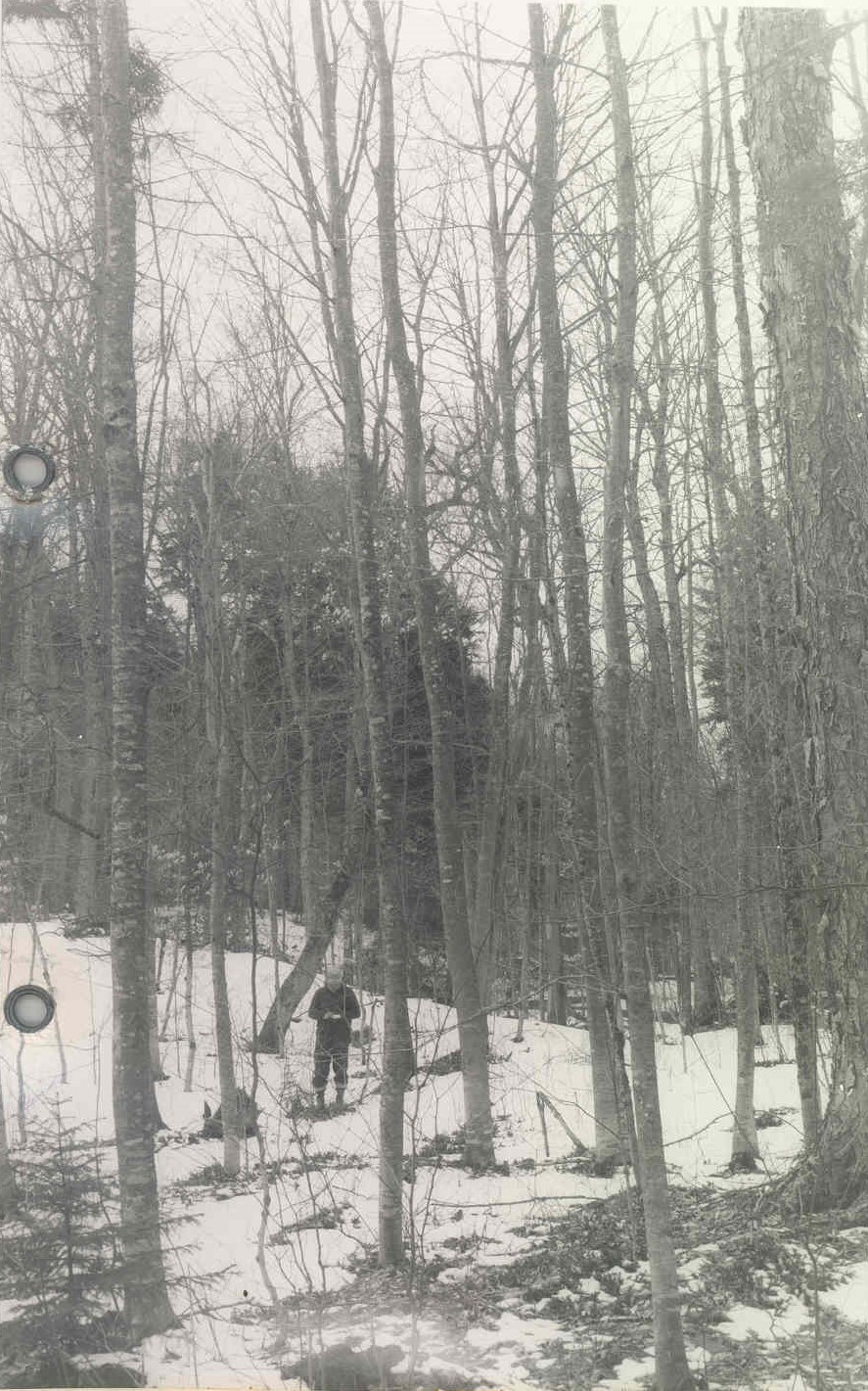| Collection: | Paul Smith Experimental Forest Historical Photo Archive |
| Keywords: |
personnel hardwood old growth |
| Organisms: |
yellow birch beech |
| Location: | Paul Smith Experimental Forest |
| Description: | The continuing decadence of yellow birch over 200 years old create openings favorable for beech and other tolerant hardwoods. |
| Date: | 1950 |
| Collection: | Paul Smith Experimental Forest Historical Photo Archive |
| Keywords: |
personnel hardwood |
| Organisms: |
beech yellow birch maple |
| Location: | Paul Smith Experimental Forest |
| Description: | A situation that is common in the Adirondacks: mature yellow birch and hard maple, with beech in a secondary position. In similar stands, cutting of the better hardwoods -- with only a limited market for beech -- has put beech in a dominant position. With the abundance of beech reproduction of all sizes, lack of hard maple of similar sizes, and the intolerance of the birch, it appears that beech can remain in possession of such sites for a long time. "Is this desirable or undesirable?" |
| Date: | 1950 |
| Collection: | Paul Smith Experimental Forest Historical Photo Archive |
| Keywords: |
gap personnel hardwood reproduction |
| Organisms: |
maple beech |
| Location: | Paul Smith Experimental Forest |
| Description: | Large openings encouraged hard maple and beech reproduction. The large trees did not meet current standards of merchantability and were not wanted by the cutters 6 years earlier. Improving markets may permit harvest of some trees in the furture, but others are cull. "Can and should anything be done to help the better saplings? Would there be long-range benefits to compensate for investments made to improve the stand?" |
| Date: | 1950 |
| Collection: | Paul Smith Experimental Forest Historical Photo Archive |
| Keywords: |
personnel stump post-harvest reproduction |
| Organisms: |
beech maple yellow birch |
| Location: | Paul Smith Experimental Forest |
| Description: | The same place after the first cut. Poor quality beech were poisoned 19 months earlier, and were debarked with frill and sodium arsenite for $4.13 per acre. It is anticipated that hard maple and yellow birch reproduction will have a better opportunity to become established without competition from the beech. |
| Date: | 1950 |
| Collection: | Paul Smith Experimental Forest Historical Photo Archive |
| Keywords: |
personnel reproduction |
| Organisms: |
beech maple |
| Location: | Paul Smith Experimental Forest |
| Description: | "On some spots beech were nearly all poisoned. We can compare the results with other compartments where varying numbers of beech were left. Hard maple advance reproduction is abundant here. It is about 14 inches high and 7 years old. Most of those about 3 feet high are beech. What will happen to them?" |
| Date: | 1950 |
| Collection: | Paul Smith Experimental Forest Historical Photo Archive |
| Keywords: |
post-harvest gap regeneration |
| Organisms: |
beech witch hobble |
| Location: | Paul Smith Experimental Forest |
| Description: | On higher ground, beech and witch hobble occupied some large openings 3 years after cutting. |
| Date: | 1950 |
| Collection: | Paul Smith Experimental Forest Historical Photo Archive |
| Keywords: |
personnel hardwood |
| Organisms: |
beech yellow birch maple |
| Location: | Paul Smith Experimental Forest |
| Description: | The natural area also contains stands of northern hardwoods. Here, beech have developed beneath large yellow birch and hard maple. |
| Date: | 1950 |
| Collection: | Paul Smith Experimental Forest Historical Photo Archive |
| Keywords: |
personnel hardwood old growth |
| Organisms: |
beech maple yellow birch |
| Location: | Paul Smith Experimental Forest |
| Description: | Mature norther hardwoods containing many intermediate beech. In this stand ages of mature trees averaged; hard maple 235, yellow birch 218, and beech 230. |
| Date: | 1950 |
| Collection: | Paul Smith Experimental Forest Historical Photo Archive |
| Keywords: |
regeneration hardwood post-harvest clearcut |
| Organisms: | beech |
| Location: | Paul Smith Experimental Forest |
| Description: | Residual and second growth northern hardwoods on a "clearcutting". A large number of beech remain. |
| Date: | 1950 |
| Collection: | Paul Smith Experimental Forest Historical Photo Archive |
| Keywords: |
old growth hardwood |
| Organisms: | beech |
| Location: | Paul Smith Experimental Forest |
| Description: | The control plot was not disturbed. Beech saplings can grow even under this dense overstory, but there are fewer beech seedlings than occur on the selection plot. |
| Date: | 1950 |










